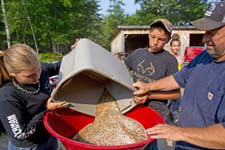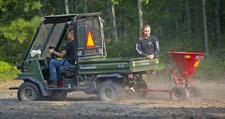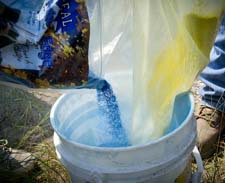SHOWCASING: Northern Michigan Deer PLAN projects aim to improve habitat, health of the herd
Michigan Department of Natural Resources sent this bulletin at 10/30/2014 01:15 PM EDT|
Grant projects funded by new hunting license revenue |
 |
 |
 |
 |
 |
Showcasing the DNR
Northern Michigan Deer PLAN projects aim to improve habitat, health of the herd
When hunting license fees went up in 2014 (for the first time in 17 years), hunters were told that a good portion of the increased revenue would be used to improve wildlife habitat across the state. The question on many hunters’ minds this fall as they purchase their deer license has been: How is that money being spent?
A prime example is the Department of Natural Resources’ new Deer Private Land Assistance Network, a grant program funded by hunting license sales that is designed to improve deer habitat on private land in the northern Lower Peninsula.
Commonly known as the Deer PLAN, the grant program, which is administered by the DNR's Wildlife Division, aims to produce tangible deer habitat improvement benefits and reduce negative impacts to agricultural operations, while fostering positive relationships between the DNR, sportsmen’s organizations, private landowners, and other partners.
Deer PLAN grants were awarded for the first time in 2014 to 12 recipients, and another 10 projects were approved for completion in 2015. The grants can be used for projects within six counties in the northern Lower Peninsula -- Presque Isle, Montmorency, Alpena, Crawford, Oscoda, and Alcona -- for work ranging from selective timber cuts and planting of mast (fruit and nut)-producing trees, to the creation of wildlife breakout areas and food plots. To participate in the program, landowners who receive grants are required to pay a minimum of 25 percent of the project costs.
"Some projects have been small perennial food plot plantings; others were as large as putting in several hundred oaks and crabapple trees on a couple of hundred acres," said Brian Piccolo, the DNR wildlife biologist that oversees the Deer PLAN program. Grants are awarded on a competitive basis and potential projects are scored on a number of criteria, including whether public access to the land is available. While public access is not required it is highly desired, and projects with provisions that allow a minimum of foot access to the public for hunting and fishing will have an advantage in the project scoring process.
Grants are awarded on a competitive basis and potential projects are scored on a number of criteria, including whether public access to the land is available. While public access is not required it is highly desired, and projects with provisions that allow a minimum of foot access to the public for hunting and fishing will have an advantage in the project scoring process.
Proximity to active agricultural lands – in order to assist in reducing negative impacts deer can have on agricultural operations, including crop damage and the spread of bovine tuberculosis – is also a priority in the scoring process.
“The Deer PLAN dovetails nicely with the state’s bovine tuberculosis management plan,” Piccolo said. “The main management objective in these six counties is to eradicate bovine TB. With improved habitat that attracts deer to more desirable areas, the herd should be healthier, hunters are more likely to see and harvest deer, and improved habitat should spread the herd out more across the landscape and away from agricultural operations.
“These outcomes will not only help to decrease the possibility of disease transmission from deer to deer, but it will also help to pull deer away from areas of high concentration, such as pasture and row crop fields. In doing so, participants will help to deter crop damage from local farms and will assist in the eventual eradication of the disease in the wild deer herd.”
The Deer PLAN is funded by hunting license sales, including the state’s new base license required of all hunters to support habitat and conservation work, and the Deer Range Improvement Project funds collected from the sale of deer licenses.
John Roper, who owns a 40-acre parcel near Ocqueoc in Presque Isle County, applied for and received a grant that he says has already worked wonders.
“I had some open ground, about three acres surrounded by woods, and I always tried to get some things going for the deer, but I never could come up with a sustainable plan because of the costs,” he said. “But when I heard about this grant program, I applied for it, and now I’ve got a pretty good crop going.
“We put in clover and alfalfa and then put in oats as a cover crop. That’s something that’s going to last for three or four years and it’s amazing to see how many deer come in and forage on it. Obviously there was a need for something like that because I’ve got about half the forest feeding in there now. In my area, there’s mostly jack pine and low swamp area, but there’s really not much of a food source there for the deer. So these crops are just a great supplement for them.”
Roper’s property is surrounded by state land on four sides, so public-land hunters will benefit from the deer coming and going from the planted field along with hunters on Roper’s land. And that’s all part of the PLAN.
“Deer are traveling constantly, that’s no secret, whether it’s to or from winter range or summer range or from bedding to feeding areas,” Piccolo said. “A lot of times they’re crossing public land to get to these project areas. When we score the projects, if the land adjoins public land on four, three or even two sides, it scores higher and is more likely to get funded.”
Although there have been some eyebrows raised about using public funds for projects on private land, Piccolo points out that 76 percent of land in Michigan is privately owned, so good habitat management on these properties greatly impacts the overall quality of the state’s deer herd.
“Public land is not getting the short end of the deal,” Piccolo said. “The far majority of money generated by hunting license sales is earmarked for the management of state land. But we’ll never reach the full potential for managing wildlife habitat in this state by only working on public land.”
Piccolo said one of the Deer PLAN grant recipients is improving habitat by replacing lost hard-mast trees by planting oak trees and crabapples.
“He had removed most of the ash that was dying from emerald ash borers, and a lot of his beech trees were cut, due to the presence of beech bark disease. That’s where the planting of oaks for this property becomes so valuable because their acorn production will replace the loss of mast-producing beech trees that are so important to deer,” Piccolo said.
David Dillon, who received a Deer PLAN grant in 2013, planted a combination of apple trees and clover food plots to draw deer out of the adjacent lowland areas on his property to improve hunting opportunities and harvest rates.
“These lowland areas are holding a lot of deer but they are difficult to hunt because it’s such thick cover” said Dillon.
Improving hunter harvest rates within the six-county area accomplishes the Deer PLAN’s goal of reducing herd density in the TB zone. Increased opportunity for a successful hunt can also lead to improved recruitment and retention of hunters. The apple trees and food plots Dillon planted are in close proximity to deer hunting blinds that he makes available to youth hunters and veterans with disabilities looking for a place to hunt. (Deer PLAN project proposals that allow special access for hunting by youth or veterans with disabilities receive additional points in the competitive scoring process.)
The apple trees and food plots Dillon planted are in close proximity to deer hunting blinds that he makes available to youth hunters and veterans with disabilities looking for a place to hunt. (Deer PLAN project proposals that allow special access for hunting by youth or veterans with disabilities receive additional points in the competitive scoring process.)
“Hunter recruitment and retention are important to me” said Dillon. “These areas created with Deer PLAN funds have increased deer harvest on my property and they are providing great spots for kids and disabled vets to hunt over.”
Piccolo said most grant recipients are “ecstatic” about the PLAN. John Roper certainly is.
“I wanted to get my grandchildren involved in it, get them thinking about creating habitat for deer and getting their hands dirty,” he said. “I think it’s a great plan. And it was a good experience working with the DNR on it – we sat down and worked out what to plant and how to do it, what kind of fertilizer to use, and what kind of weed control to do.
“This gave us an opportunity to do it right and you can tell it’s paying off.”
To learn more about the DNR's wildlife habitat improvement grant programs, including the northern Lower Peninsula Deer PLAN, and how to apply, visit www.michigan.gov/dnr-grants.
###
NOTE TO EDITORS: Photos to accompany this story are available for download at http://www.michigandnr.com/ftp/outreach/. (Michigan DNR photos)
Captions:
DSK506 42: Matthew Perrou and Aubrey Roper, grandchildren of Deer PLAN grant recipient John Roper, spread fertilizer on the future site of new food plots that are surrounded by public land in Presque Isle County. The food plots will help attract deer for hunters on both public and private land.
DSK506 45: Deer PLAN grant recipient John Roper, joined by grandchildren Aubrey Roper and Matthew Perrou, prepares fertilizer for land he is converting to food plots on his property near Ocqueoc in Presque Isle County. The planted openings will provide a food source for deer and other wildlife on his property and nearby public land.
DSK506 62: Grant recipient John Roper watches as grandson Matthew Perrou loads seed into the hopper for planting. Roper involved his grandchildren in his Deer PLAN project to encourage an appreciation for wildlife habitat management at a young age.
DSK506 69: John Roper and grandson Matthew Perrou plant seed on Roper’s property in early September. Converting the formerly unproductive small openings into food plots will help attract deer to an area that is surrounded by public hunting land, one goal of the DNR’s new Deer PLAN grant program.
DSK506 93: Roper prepares a fertilizer mix before spreading it on the land he will convert into food plots as part of the DNR’s Deer PLAN habitat program. DNR staff provided Roper with technical guidance and advice regarding use of fertilizer, weed control and seed to successfully convert unproductive openings into productive food plots.
Showcasing the DNR was originally designed for weekly news publications, but we invite everyone to share these stories with friends, family and anyone who would like to learn more about Michigan’s great outdoors and cultural heritage. Media organizations are welcome to cut and paste these stories for use with their own readers and website visitors. Use the Internet link (at the end of this email) to access photos to supplement the story.